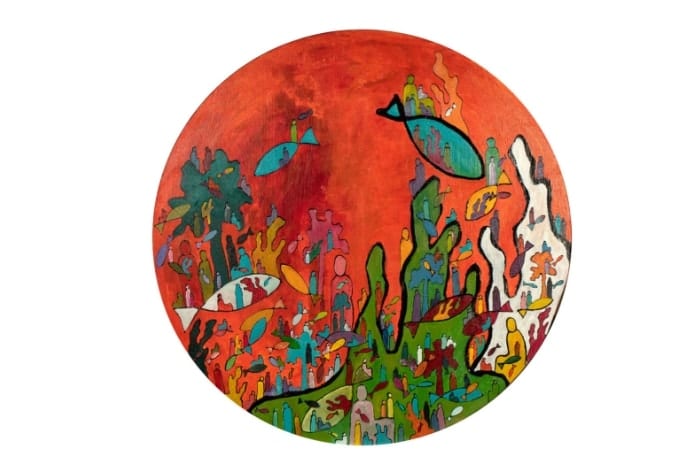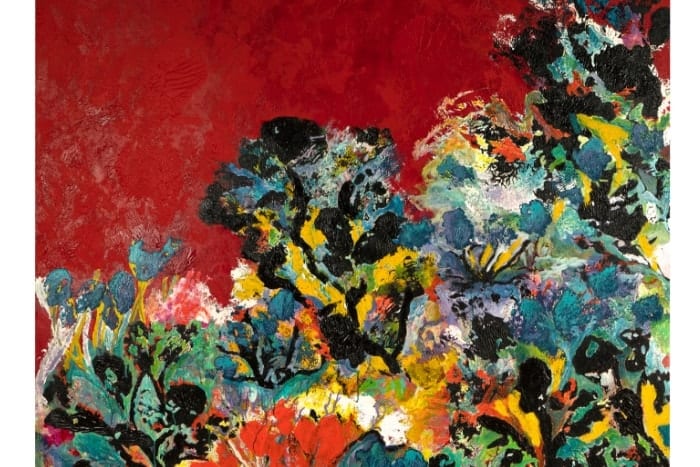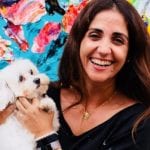Rhapsodise to the soundtrack of a local artist’s music-inspired artwork at her solo exhibition in the N2N Gallery on 18 October
Noura Ali-Al Ramahi is an Abu Dhabi-based artist who infuses joy into every painting. Her most recent series, aptly named Rhapsody, is – bright, bold, colourful, and fun. It’s also a stark contrast to her earlier poignant work, where she worked through complex emotions surrounding her birthplace (Lebanon) and the plight of Syrian refugees. Rhapsody is a complete departure, and it will make your heart sing. Yalla spent a morning in Noura’s studio to learn more about this remarkably prolific and brilliant artist.

First, when did you first start painting? Were you born with a paint palette in hand, or did your interest in art develop over time?
My earliest memory of painting and drawing is when I was about 14 years old when we first moved to Dubai from Lebanon (1989). I have some of these drawings dated 1990/1991 hanging in my daughter’s room. They were drawings I copied from pictures and books. At that time, I also tried silk painting, and I was into crafts as well.
My art hobby had its cycles; times when I was spending a lot of time drawing and colouring and time when I did absolutely nothing.
But, I would say the next more serious phase of my journey in art was between 1993 and 1997 when I was a university student in Beirut. I loved the terracotta pots markets in Beirut. So, I bought a few pots and some acrylic paint (you can use acrylic on pretty much ANY surface and it is super easy to use. That’s why I’ve stuck with it till today), and I began to paint the pots—I painted a lot of pots.
Our home in Beirut is filled with these pots of different shapes and sizes. Then one day I picked up a piece of A4 paper and painted my very first painting, totally out of my own imagination, not a copy. It was a black and white figure of a woman standing alone with a dab of red. I still have that piece. That was I think the start of my “obsession” with drawing figures and people.
Tell us a bit about your background. How has where you are from influenced your work (if it has)?
I was born in Beirut, Lebanon in the middle of the civil war. Despite the traumas that came with the war, I had a happy childhood. But war leaves scars in one’s mind, and they come out in my paintings, especially when I was working on my series entitled Displaced, the subject of which was refugees.
I spent just over a year in Scotland when I was 10 years old, and that is when I fell in love with nature, greenery, trees, and open fields. Many of the works that I am producing now reflect a certain longing for nature and being outdoors. So, there are definite links between the places I’ve been (as a child and as an adult) and the artworks I produce at different times in my life.
I have to mention here that travelling is a huge passion for me. We are lucky to be living in the UAE, which has such a central location. We travel a lot, and my travels come out in my paintings.
You come from a line of creative people. Can you tell us a bit about your family and past exhibitions where you have exhibited together?
My mother (a retired physics teacher) is an oil painter (landscapes and still-life), and my uncle (her brother) is an architect but has painted all his life. I remember some of his paintings from when I was 9 or 10 years old. I have always tried to paint like him. His work has greatly influenced me.
My first exhibition in January 2016 (A Picture and a 1000 words) included artworks by me, my mother, and my uncle. The exhibition also featured poetry readings by my sister Sarah who is a very talented poet. Many of my paintings in that first exhibition were inspired by her poems and carried the names of her poems.
After that first exhibition, it was full steam ahead for me and my art practice. I built a studio in my home and started taking art more seriously. I held two small open house exhibitions in my home over the past couple of years. In 2017, I participated in World Art Dubai, my first art fair experience. It was a very interesting experience. It connected me with a wider audience and helped me learn to speak about my art, learn how to describe it and articulate the inspiration behind it, and the process it goes through.
What does your average creative workday look like? Do you try to paint a bit every day, or do you work in concentrated bursts?
I have a full-time job and four kids. So, waiting for the right time when I am absolutely free to sit and paint all day is pointless. I paint any spare moment I have. Sometimes for five minutes before I drive the kids to school, I walk into my studio and add a stroke of paint to a piece that I’m working on.
In fact, it is a ritual I developed. I have to walk into my studio every morning, sometimes just to look around, think about what I want to do later that day when I come home from work, or simply to take a few morning pictures for Instagram.
On weekends, I can spend six to seven hours a day painting. When I’m working on a specific project or commission, I dedicate a lot more hours to painting. At night when I put the kids in bed, I can be in my studio until late into the night. Hardly a day goes by that I don’t paint.
I absolutely love painting. Being in my studio gives me an immense send of joy. I feel peace. I feel excitement, and frustration. I take risks. I push my limits. I challenge myself. I meditate. I learn, and I listen to my favorite music.

Arabian Rhapsody
Your new new solo exhibition Rhapsody at the N2N Gallery includes paintings which feature “marine” creatures”. Have you always been interested in the marine world as a subject matter?
I first became fascinated with the world that exists beneath the sea when I did my first diving trip 17 years ago, and I’ve been fascinated by it ever since—I could not imagine a world so colourful and so beautiful.
But what inspired me to start painting about the subject of corals is watching a documentary called Chasing Corals. That’s why I call my series “Chasing Corals”. It is very sad what is happening to our oceans and seas. The plastic epidemic we face is huge, and I wanted to do my small part in raising awareness about this subject.
Tell us how transitioned from the intense faceless people you represented in your work on Syrian refugees to these colourful and seemingly light reveries.
I realized after producing tens of paintings on the refugee theme that I was focusing on a really depressing subject, and I didn’t want to be boxed in to one theme and one subject. Then I saw Chasing Corals, and I happened to take a couple of snorkeling and diving trips with my kids to the Maldives and that triggered the transition to a more colourful subject, highlighting the beauty of the world beneath the water. Having said that, there is a subtle negative underlying message because I am saddened by the thought of these corals disappearing forever due to pollution and other human factors.
Do you have a personal favourite piece in Rhapsody?
It has to be the first one I ever made in the series, before I even had a name for it. The piece is called Bohemian Rhapsody, and it was the most fun to make.
Describe the relationship in your Rhapsody paintings with music as many are named for popular songs?
When I began working on the Rhapsody series, combining my human figures with my coral theme, I didn’t really understand why I was combining those 2 subjects in such a fantasy like, surreal world. I didn’t know how to explain these new artworks that I was creating, didn’t have a clue what I would call them.
And one day, driving home from work, the song Bohemian Rhapsody started playing in the car, and I was immediately struck by the word “rhapsody”. So, I googled its meaning and as soon as I read the meaning I knew that was the tittle of the series, and I knew that each piece will be named after one of my favorite songs. The songs that remind me of a simpler time, a less technologically driven time, and a time before social media addiction.
Rhapsody is an emotional chant or song or poem that does not necessarily follow a specific rhythm or structure, and that’s precisely what my series represents. Not only that, “rhapsody” described pretty much my entire approach to art. I move from one subject to another, one style to another, one technique to another depending on my feelings and inspiration.
I don’t follow any rules, and I don’t put limitations on what I paint or how I produce my paintings. And being self-taught allows me that freedom. I am not bound by specific rules or technique of composition, or color coordination; I just paint using my instincts, through trial and error, through letting go of my mental judgement or boundaries, to just freely experiment and let that freedom guide me, to take risks and try new things.
Who are greatest art influences?
My favourite artists include Willem Dekooning, Paul Guiragossian, Joan Mitchell, Franz Kline, Fateh Mudarres, and Mohamed Al Mazrouei.
How does it feel to have your first solo exhibition?
It feels amazing. I am very proud, excited, and a bit nervous. I always feel very vulnerable when I hold an exhibition. It is a very emotional experience: putting my work in front of new and old audiences. I love feedback and value critique, but putting my works on exhibit means putting myself out in front of the world too, allowing people to peer directly into my heart and mind. It is a bit daunting for me, and it is always a very humbling experience.

Drop by Noura Ali-Al Ramahi’s exhibition at the N2N Gallery in Al Ain Tower, Al Khalidiyah (entrance through Costa Coffee). The reception is free and open to the public on Thursday, 18 October and runs until 7 November 2018. To learn more, please email [email protected].
Visit Noura’s website www.nouraramahi.com or follow her on Instagram @nouraramahi.

